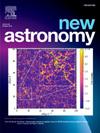Studying orbital period variations of XY Leo through updated eclipse times and multi-model analysis
IF 2.1
4区 物理与天体物理
Q2 ASTRONOMY & ASTROPHYSICS
引用次数: 0
Abstract
This study revisits the orbital period variation of the short-period eclipsing binary system XY Leo, a W-subtype W Ursae Majoris (W UMa) contact binary, by analyzing 30 newly collected mid-eclipse times from three telescopes between 2015 and 2021. The obtained light curves and residuals showed no deviations attributable to effects like pulsations or starspots. The updated diagram, covering 77 years and extended by four years of new data, revealed minor deviations from previously published models. Three models were applied using MCMC sampling to analyze the orbital period variations of XY Leo. Model I includes the linear ephemeris, a quadratic term, and the Light Travel Time (LTT) effect of a 3rd body orbiting the central binary system. Models II and III add a sinusoidal function for the magnetic cycle and the LTT effect of a 4th body to Model I, respectively. Updated orbital parameters for the 3rd body are slightly larger than earlier estimates, except for . Applegate mechanism analysis of the magnetic cycle indicated possible magnetic activity, though the derived period (28.09 years) exceeds the expected range. For the first time, Model III considers a 4th body, yielding the lowest RMS and systematic error, suggesting better compatibility with the diagram. Orbital stability tests confirmed stable orbits for Models I and II over one Myr, while Model III showed no stability. Persistent oscillations in Model I residuals suggest that the orbital period variation requires additional explanations, such as magnetic cycles or the influence of further companions.
通过更新的日食时间和多模型分析研究XY狮子座的轨道周期变化
本研究通过分析2015年至2021年间三台望远镜新收集的30次月食中期数据,重新审视了短周期食双星系统XY狮子座(W -subtype W Ursae Majoris (wuma)接触双星)的轨道周期变化。获得的光曲线和残差显示没有可归因于脉动或星斑等影响的偏差。更新后的O−C图涵盖了77年的时间,并增加了4年的新数据,显示出与以前发表的模型有轻微的偏差。采用MCMC采样方法,对XY Leo的轨道周期变化进行了三种模型分析。模型1包括线性星历、二次项和绕中心双星系统运行的第三个天体的光行时(LTT)效应。模型II和模型III分别为磁周期和第4个体的LTT效应增加了正弦函数。第三个天体的更新轨道参数比之前的估计略大,除了e3。磁周期的Applegate机制分析表明可能存在磁活动,但推导出的周期(28.09年)超出了预期范围。模型III第一次考虑了第4个体,产生了最低的均方根和系统误差,表明与O−C图有更好的兼容性。轨道稳定性测试证实,模型I和模型II的轨道在1 Myr内是稳定的,而模型III则不稳定。模型I残差中的持续振荡表明,轨道周期的变化需要额外的解释,例如磁周期或其他伴星的影响。
本文章由计算机程序翻译,如有差异,请以英文原文为准。
求助全文
约1分钟内获得全文
求助全文
来源期刊

New Astronomy
地学天文-天文与天体物理
CiteScore
4.00
自引率
10.00%
发文量
109
审稿时长
13.6 weeks
期刊介绍:
New Astronomy publishes articles in all fields of astronomy and astrophysics, with a particular focus on computational astronomy: mathematical and astronomy techniques and methodology, simulations, modelling and numerical results and computational techniques in instrumentation.
New Astronomy includes full length research articles and review articles. The journal covers solar, stellar, galactic and extragalactic astronomy and astrophysics. It reports on original research in all wavelength bands, ranging from radio to gamma-ray.
 求助内容:
求助内容: 应助结果提醒方式:
应助结果提醒方式:


